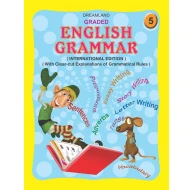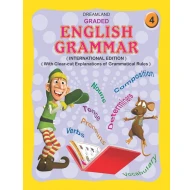
Short Description
In this excerpt, Amoli searches frantically for a missing gadget, perplexed by its disappearance from its secure location. As she contemplates whether it was stolen or vanished by magic, she reflects on the dedication of her daughter and the circumstances of writing the book during lockdown, honoring Covid-19 warriors. This snippet hints at a tale of mystery and adventure, tinged with personal dedication and the backdrop of a challenging time.In this excerpt, Amoli searches frantically for a missing gadget, perplexed by its disappearance from its secure location. As she contemplates whether it was stolen or vanished by magic, she reflects on the dedication of her daughter and the circumstances of writing the book during lockdown, honoring Covid-19 warriors. This snippet hints at a tale of mystery and adventure, tinged with personal dedication and the backdrop of a challenging time.
More Information
| ISBN 13 | 9798885750899 |
| Book Language | English |
| Binding | Paperback |
| Total Pages | 248 |
| Release Year | 2023 |
| GAIN | 09VH375TBN4 |
| Publishers | Garuda Prakashan Rati : An Imprint Of Garuda Prakashan |
| Category | Children Books Intrigue |
| Weight | 230.00 g |
| Dimension | 13.97 x 21.59 x 1.48 |
Customer Rating
Reviews
Junjunwadi Tales
Lovely Piece of Literature
Junjunwadi Tales
Junjunwadi Tales
Junjunwadi Tales
Must Read
Junjunwadi tales
Frequently Bought Together

This Item: Junjunwadi Tales
₹325.00
Sold by: Garuda Prakashan
ADD TO CART



This Item: Junjunwadi Tales
Sold By: Garuda Prakashan
₹325.00
Total Price : ₹325.00
Product Details
A sample... Amoli reached for the trunk and fished a hand inside it. She was still planning the details in her head as her hand rummaged around, searching for the gadget inside the trunk. She stopped thinking and opened the trunk and removed the layers of cloth which were used to camouflage the gadget. Her heart skipped a beat, but then, it was impossible to think that it could be misplaced. This had never happened in all these years. It was safest to keep it here because she was the only one besides her brother who had access to this room. The gadget had never ever been anywhere else other than inside the trunk. Amoli sat on the chair and closed her eyes. Somehow, the impossible had happened. Was it some kind of magic again that had made the gadget disappear? Or was it missing because it had been stolen by someone?
The thunderous applause continued and she could see everyone in the crowd reaching out so that they could touch her. Suddenly, someone grabbed her by her hand and began shaking it with excitement. She was unable to withdraw her hand because of the pressing crowd and the firm grip of the person who was shaking her hand.
“Amoli… Agga… Utt ga… Utt lavkar!” (Wake up!)
She slowly realised that it was her mother who was vigorously shaking her with one hand, ending her dream abruptly. It took her some time to open her heavy eyelids and then some more time to accustom herself to the darkness in the room.
“Agga, Aai… Yeth nahi na pan…” (But, Mom… I don’t want to…)
“Aadi yeth nahi. Pan nantar savai lagal. Chal lavkar, ujed vaycha aat.” (C’mon. You will get used to it. Let’s go before the sun rises…)
“Chi! Kashala mothi zaali me. Baherach basaaychi, tech bara hota…” (Mom… Why did I grow up so soon?)
“Thobaad fodin zar faltu bolshily tar. Chal tumbrel uchal ann chalayla lag.” (Get up fast or else I will slap you!)
It was still darkness when mother and daughter stepped out of their hut and began briskly walking on the beaten mud path. A little ahead, they approached a similarly paired couple who seemed to be waiting for them. There was no exchange of words and the couple joined the mother and daughter on the journey.
The walking continued for another five minutes until they veered to the left, off the path, and entered a thick undergrowth of bushes and wild greenery.
Her mother held her hand and beckoned her to the open space. She scanned the surroundings for any intruder and finally signalled her daughter.
Amoli shyly looked down, lifted her gown up to her knees and squatted.
1
Amoli, if she had been going to school regularly, like in the big city or the town, would have been in the sixth or seventh grade. Add approximately five years to it and you can easily guess how old she was.
To Amoli, barring the few special occasions of the Hindu calendar, yesterday was the same as today and tomorrow would be the same as today. And it would continue to do so for the entire year.
Yesterday began with the usual forced call of nature and then rushing back home for the daily chores. Tomorrow would be the trek of a few kilometres to fetch drinking water while her parents worked in the fields as daily labourers.
Initially, Amoli was very happy when her parents stopped sending her to school as soon as she was old enough to cook food and take care of her younger brother, who continued going to school as seemed to be his prerogative. But like most kids of her age, her mind was full of questions and sometimes she wondered whether their decision of not sending her to school was right.
Maratha
Maratha, as a name, first appeared in a 7th century inscription and then in the documented accounts of the Chinese traveller Xuan Zang. The name might have been derived from the word maharathi, which means ‘great charioteer’. The local language intermingled with the speech of the earlier Naga settlers and, by the 8th century, developed into Marathi. Interestingly, there was also a continuous influx of people from as far as Greece and Central Asia.
The Hindu kingdoms of the Satavahanas, the Vakatakas, the Kalacuris, the Rashtrakutas, the Chalukyas and the Yadava rulers were followed by a succession of Muslim dynasties. Persian, the court language of the Muslims, had a far-reaching effect on the Marathi language. By the mid-16th century, Maharashtra was again fragmented between several independent Muslim rulers who fought each other endlessly. It was in the midst of that chaos that a great leader, Shivaji, was born. Shivaji showed astonishing prowess at a very young age and founded a large Maratha empire in the coming years that shook the Delhibased Mughal rule to its foundations.
During the 18th century, almost all of western and central India as well as large segments of the north and east were brought under the control of the Maratha confederacy, an alliance formed after Shivaji’s kingdom had collapsed. Europeans, however, had been present along the coast since the early 16th century. Britain gained control of Bombay Island in 1661, and from early 19th century onwards, the Marathas gradually succumbed to British expansion on the mainland. The British proceeded to establish an administrative province known as the Bombay Presidency. Three years after India gained its independence, the province became Bombay State. A number of former princely states like Baroda subsequently were merged into the new state.
On November 1, 1956, in a major linguistic and political reorganization of the states of peninsular India, Bombay State received large parts of Madhya Pradesh as well as the northwestern portion of the dismembered Hyderabad state. The latter had been formed after Indian independence from the former Hyderabad princely state. The outcome of that reorganization, however, was still a linguistically divided state, in which most of the Gujarati speaking people lived in the north and most of the Marathi speaking people lived in the south.
Demands by the two language groups that the state be divided into two parts resulted in the creation of Gujarat in the north and the newly renamed Maharashtra in the south. The day was May 1, 1960.
Maharashtra
Maharashtra is a large geographical chunk of the Deccan plateau, the western peninsular part of the subcontinent. It’s shape roughly resembles a triangle, with a 725 km western coastline forming the base and its interior narrowing to a blunt apex some 800 km to the east. Maharashtra is bound by the states of Gujarat to the northwest, Madhya Pradesh to the north, Chhattisgarh to the east, Telangana to the southeast, Karnataka to the south, Goa to the southwest and the union territory of Dadra Nagar Haveli and the Arabian Sea to the west.
Like other states, Maharashtra also represents the country’s physical diversity. To the west is the narrow Konkan coastal lowland till it reaches its widest extent near Mumbai. Numerous minor hills dominate the relief. There are many tiny and rapid west-flowing streams.
Ghat in Marathi means “a mountain pass” or a navigable route. The Western Ghats, situated at the western edge of the Deccan plateau, run almost continuously for 640 km northsouth with the foothills reaching up to 6.4 km of the Arabian Sea. The eastern slopes of the ghats descend artistically towards the Deccan plateau and are sculptured by the subtle yet supple valleys of the Krishna, the Bhima and the Godavari rivers.
Then, there is the Narmada river valley to the north and the Krishna basin to the south and the western coast. The ghats and the triangular plateau inland are covered with extensive lava outpourings called traps. The varying erosion of lava has resulted in typical slopes, uniform crest lines and a tabletop appearance of many hills in Maharashtra.
The Deccan traps give way to undulating uplands underlain by age-old crystalline rocks. The Wardha-Wainganga valley, part of the larger Godavari basin, trends southward having many lakes.
The Western Ghats and the ranges on the northern borders greatly influence the climate and separate the wet Konkan Coast from the dry interior upland, an area called the ‘Desh’. This is bounded on the north by the ‘Khandesh’ and on the east by the Marathwada region.



.webp)









